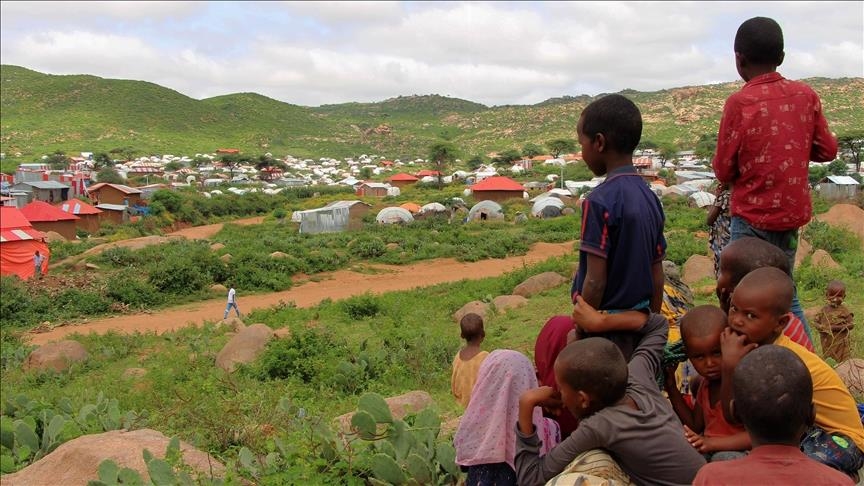
- ‘We have fled war, but we are now about to face starvation in Uganda,’ says Sudanese refugee Iman Mohammed
- Without immediate funding, further cuts or a total halt of assistance may follow, warns WFP spokesperson Alessandro Abbonizio
KIRYANDONGO, Uganda
After several days of travel, sometimes navigating through the bushes of Sudan’s Darfur region to avoid armed groups and checkpoints, Amin Ahmed, his wife Rania Bashir, and their two children managed to flee the country.
The family of four is now seeking asylum at the Kiryandongo Refugee Settlement in mid-western Uganda, home to thousands of other refugees from Sudan, South Sudan, and the Democratic Republic of Congo.
“We felt a sense of relief and hope upon arriving in Uganda. What we experienced back home in Sudan was very horrifying. We saw many people killed,” Ahmed, 32, told Anadolu.
Like other refugees, Ahmed was given a small plot of land by the UN refugee agency, UNHCR, to build a temporary shelter for his family.
“Life was good when we first arrived here two years ago. The World Food Program used to provide us with 10 kilograms (22 pounds) of maize meal, 3 kilograms (6 pounds) of beans, two packets of salt, and a liter of cooking oil each month,” he said.
“But things have now changed. There is no food,” he added, gesturing toward his hungry children, aged 3 and 5.
There are times when they go days without eating, he said.
“Currently, we receive only 10,000 Ugandan shillings (around $3) per person from the UN each month,” he said, saying that the money is not enough to last 30 days.
Iman Mohammed, another Sudanese refugee and a mother of three, also warned of the dire conditions facing the thousands of displaced people in the camp.
“We have fled war, but we are now about to face starvation in Uganda,” Mohammed, 30, told Anadolu.
She now relies on occasional handouts or odd jobs within the camp.
“Uganda is peaceful. The people are good, but there are no jobs. Opportunities are limited,” she said.
Funding crisis deepens
The UN’s World Food Program (WFP) has long supported refugees in East Africa with food aid and livelihood programs aimed at boosting self-reliance.
But the WFP is now grappling with a spiraling funding crisis after the US – its largest donor – abruptly cut nearly all contributions and dismantled the US Agency for International Development (USAID) earlier this year.
The move, part of a broader rollback of foreign aid under President Donald Trump, has devastated humanitarian operations across East Africa.
Washington had been the backbone of WFP’s relief work, contributing nearly $4.5 billion – more than four times the amount provided by the next-largest donor, Germany – in 2024, and nearly half of all historic funding.
In Uganda alone, USAID provided $83 million between 2023 and April 2024, supporting more than 1.3 million refugees across 13 settlements.
That lifeline is now gone.
Even before the cuts, the program had been reducing food rations and cutting support in places like Kenya and Uganda due to chronic underfunding, Alessandro Abbonizio, WFP spokesperson in Nairobi, told Anadolu.
Then, in May, WFP slashed the number of refugees it supports in Uganda from 1.6 million to 663,000.
“Refugees classified as moderately vulnerable are receiving just 22% of a food ration – the lowest ever provided in Uganda and the region,” Abbonizio said.
To restore full rations, WFP needs $50 million, but so far this year, it has received just $8.5 million. Without immediate funding, Abbonizio warned, further cuts or a total halt of assistance may follow.
Cuts coincide with refugee surge
The crisis comes as Uganda faces a renewed surge in refugee arrivals. Known for its open-door refugee policy, the country now hosts 1.9 million refugees, the most in Africa.
Most have fled violence in Sudan, South Sudan, and the Congo, with others coming from Somalia, Ethiopia, and Eritrea.
Unrest has again intensified across the region, already scarred by years of war.
In Sudan, fighting between the army and the paramilitary Rapid Support Forces has killed tens of thousands and displaced over 13 million people. The UN in April 2025 called it the world’s worst humanitarian crisis.
In eastern DR Congo, renewed clashes between M23 rebels and government forces displaced at least 500,000 and killed more than 3,000 by late February, according to the Africa Center for Strategic Studies.
Aid cuts are biting there too. UN Emergency Relief Coordinator Tom Fletcher warned that US aid cuts have forced the humanitarian community to make “brutal choices, life-and-death choices” in Congo, where 70% of UN aid programs once relied on Washington’s support.
Violence has also swept through South Sudan, where more than 130,000 people had been displaced by May since fighting between government and opposition forces escalated in March, according to the UN.
So far this year, Uganda has taken in 112,571 new refugees from Congo, Sudan, and South Sudan alone, UN figures show. The influx, paired with dwindling resources, is pushing already overstretched systems to the brink.
Last month, Hilary Onek, Uganda’s minister for relief, disaster preparedness, and refugees, sent an urgent appeal to the international community for support.
“Sustained international solidarity is essential to uphold Uganda’s exemplary refugee policy and ensure continued protection for those in need,” he said.
Anadolu Agency website contains only a portion of the news stories offered to subscribers in the AA News Broadcasting System (HAS), and in summarized form. Please contact us for subscription options.







